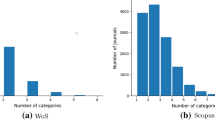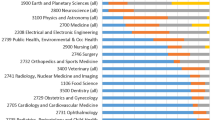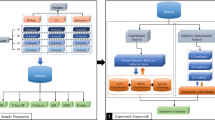Abstract
Journal classification systems use a variety of (partially) overlapping and non-exhaustive subject categories which results in many journals being classified into more than a single subject category. Given a subject category, respective journals are often ranked based on a common metric such as the Journal Impact Factor or SCImago Journal Rank. However, given a specific journal, it might be ranked very differently across its associated subject categories. In this study, we set to explore the possible association between the number of categories a journal is classified to and its associated rankings using the two most widely used indexing systems - Web Of Science and Scopus. Using known distance measures, our results show that a higher number of classified categories per journal is associated with an increased range and variance of the associated rankings within them. Findings and possible implications are discussed.
Access this chapter
Tax calculation will be finalised at checkout
Purchases are for personal use only
Similar content being viewed by others
References
Aviv-Reuven, S., Rosenfeld, A.: A logical set theory approach to journal subject classification analysis: intra-system irregularities and inter-system discrepancies in web of science and Scopus. Scientometrics, 1–19 (2022)
Bar-Ilan, J., Levene, M., Lin, A.: Some measures for comparing citation databases. J. Informetr. 1(1), 26–34 (2007)
Bordignon, F.: Tracking content updates in Scopus (2011–2018): a quantitative analysis of journals per subject category and subject categories per journal. In: ISSI, pp. 1630–1640 (2019)
Dennis, A.R., Valacich, J.S., Fuller, M.A., Schneider, C.: Research standards for promotion and tenure in information systems. Mis Q., 1–12 (2006)
González-Pereira, B., Guerrero-Bote, V.P., Moya-Anegón, F.: A new approach to the metric of journals’ scientific prestige: the SJR indicator. J. Informetr. 4(3), 379–391 (2010)
Haustein, S.: Multidimensional journal evaluation: analyzing scientific periodicals beyond the impact factor. Walter de Gruyter (2012). https://doi.org/10.1515/9783110255553
Larivière, V., Sugimoto, C.R.: The journal impact factor: a brief history, critique, and discussion of adverse effects. In: Glänzel, W., Moed, H.F., Schmoch, U., Thelwall, M. (eds.) Springer Handbook of Science and Technology Indicators. SH, pp. 3–24. Springer, Cham (2019). https://doi.org/10.1007/978-3-030-02511-3_1
Leydesdorff, L., Bornmann, L.: The operationalization of“fields’’ as WoS subject categories (WC s) in evaluative bibliometrics: the cases of “library and information science’’ and “science & technology studies’’. J. Assoc. Inf. Sci. Technol. 67(3), 707–714 (2016)
McKiernan, E.C., Schimanski, L.A., Nieves, C.M., Matthias, L., Niles, M.T., Alperin, J.P.: Meta-research: use of the journal impact factor in academic review, promotion, and tenure evaluations. Elife 8, e47338 (2019)
Nicholas, D., et al.: Choosing the ‘right’ journal for publication: perceptions and practices of pandemic-era early career researchers. Learned Publ. (2022)
Niles, M.T., Schimanski, L.A., McKiernan, E.C., Alperin, J.P.: Why we publish where we do: faculty publishing values and their relationship to review, promotion and tenure expectations. PLoS ONE 15(3), e0228914 (2020)
Pajić, D.: On the stability of citation-based journal rankings. J. Informetr. 9(4), 990–1006 (2015)
Rice, D.B., Raffoul, H., Ioannidis, J.P., Moher, D.: Academic criteria for promotion and tenure in biomedical sciences faculties: cross sectional analysis of international sample of universities. Bmj, 369 (2020)
Singh, V.K., Singh, P., Karmakar, M., Leta, J., Mayr, P.: The journal coverage of web of science, Scopus and dimensions: a comparative analysis. Scientometrics 126(6), 5113–5142 (2021)
Subochev, A., Aleskerov, F., Pislyakov, V.: Ranking journals using social choice theory methods: a novel approach in bibliometrics. J. Informetr. 12(2), 416–429 (2018)
Visser, M., van Eck, N.J., Waltman, L.: Large-scale comparison of bibliographic data sources: Scopus, Web of science, dimensions, crossref, and Microsoft academic. Quant. Sci. Stud. 2(1), 20–41 (2021)
Wang, Q., Waltman, L.: Large-scale comparison of bibliographic data sources: Scopus, Web of science, dimensions, crossref, and Microsoft academic. J. Informetr. 10(2), 347–364 (2016)
Zitt, M., Lelu, A., Cadot, M., Cabanac, G.: Bibliometric delineation of scientific fields. In: Glänzel, W., Moed, H.F., Schmoch, U., Thelwall, M. (eds.) Springer Handbook of Science and Technology Indicators. SH, pp. 25–68. Springer, Cham (2019). https://doi.org/10.1007/978-3-030-02511-3_2
Author information
Authors and Affiliations
Corresponding author
Editor information
Editors and Affiliations
Rights and permissions
Copyright information
© 2023 The Author(s), under exclusive license to Springer Nature Switzerland AG
About this paper
Cite this paper
Aviv-Reuven, S., Rosenfeld, A. (2023). Exploring the Association Between Multiple Classifications and Journal Rankings. In: Sserwanga, I., et al. Information for a Better World: Normality, Virtuality, Physicality, Inclusivity. iConference 2023. Lecture Notes in Computer Science, vol 13971. Springer, Cham. https://doi.org/10.1007/978-3-031-28035-1_31
Download citation
DOI: https://doi.org/10.1007/978-3-031-28035-1_31
Published:
Publisher Name: Springer, Cham
Print ISBN: 978-3-031-28034-4
Online ISBN: 978-3-031-28035-1
eBook Packages: Computer ScienceComputer Science (R0)




